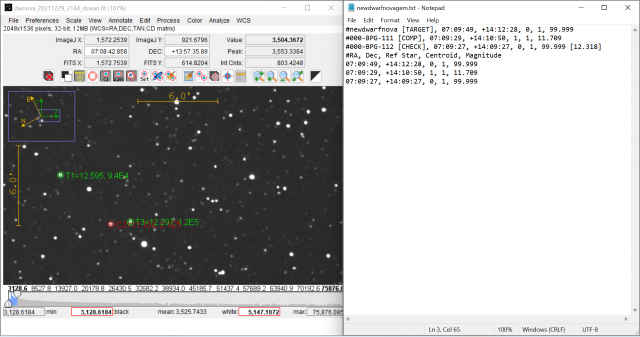Forum Replies Created
-
AuthorPosts
-
 David SwanParticipant
David SwanParticipantGood research, Robin. I thought it must have been based on something. David
 David SwanParticipant
David SwanParticipantI have just been catching up with the latest news on JWST in one of my favourite publications. This report, dated 26 Jan, suggests that one can spot the observatory in the bowl of the Big Dipper with binoculars. James Webb Space Telescope is seen from Earth as it settles into orbit | Daily Mail Online
 David SwanParticipant
David SwanParticipant David SwanParticipant
David SwanParticipantI’ve been following it closely: yes, quite amazing.
 David SwanParticipant
David SwanParticipantNew Year report from Tynemouth: windy conditions, with clouds scudding across the sky. JWST is still within reach of moderate equipment: I am able to pick it up on individual 10 second frames taken through an 8 in RASA. Frame 5 start 21:35:26; frame 67 start 21:45:57. I have enough frames to make a reliable (I think) estimate of brightness – I’ll plate solve and find some suitable comparison stars.
 David SwanParticipant
David SwanParticipantI estimated the brightness at about 12.595 CV, with a delta for the check* star (*corrected) of 0.021.

 David SwanParticipant
David SwanParticipantI acquired a set of frames last night: 2021-12-29T21:17:18 – 2021-12-29T21:25:46
Really pleased to get it, as the weather here (for astronomy, anyway) has been so poor.
 David SwanParticipant
David SwanParticipantConditions weren’t great – certainly not photometric quality – but I imaged the field and the image gives a ballpark indication of brightness (certainly consistent with Forth’s obs). Midpoint 2021-12-29T21:44. PA 297deg; 80′ x 60′.
 David SwanParticipant
David SwanParticipantHappy Christmas all! Fingers crossed that JWST launches without a hitch today, and that the whole sequence of further manoeuvres (and unpacking) goes as planned. The weather forecast for NE England over the next week shows a lot of cloud unfortunately. But I would love to image it whilst en route to L2.
 David SwanParticipant
David SwanParticipantHi Grant. I have enjoyed the recent issues. Richard Wright, Rod Mollise and Dennis di Cicco know what they are talking about: the test reports in S&T are generally more incisive than those in the other mags. Bob King is very good with his celestial calendar. The general articles: the one on Saturn’s moons in September was excellent, as was the one on RW Aur in August. Mat Wedel’s binocular stuff is useful for me when using my RASA for lazy but enjoyable EAA (I get a couple of degrees).
I don’t know how helpful this little commentary was, but it is still my mag of choice.
 David SwanParticipant
David SwanParticipantNo problem getting the mag up here in one of the outer provinces – from the local WH Smith.
 David SwanParticipant
David SwanParticipantI can confirm this Gary.
Astrometrica gave mag 12.6 (clear with V zeropoint)
 David SwanParticipant
David SwanParticipantThanks for letting us know. I’ll get on it as soon as possible – from the forecast, it looks like Sat eve may be clear where I am.
 David SwanParticipant
David SwanParticipantThis SN is in a lovely host galaxy. Picture taken 10 Apr.
 David SwanParticipant
David SwanParticipantWow, it’s bright – and so nicely placed in Cas next to M52 and the Bubble Nebula! I carried out a 41 x 5s stack this eve: not scientifically useful, but a pretty pic, I think.
 David SwanParticipant
David SwanParticipantAstrometrica puts it ~ mag 15.6
 David SwanParticipant
David SwanParticipantCaptured at 20:32 UT this evening (20 Mar).
 David SwanParticipant
David SwanParticipantGetting the spacing right can indeed be a faff. I’m sorted also with my RASA 8: a 7.5 mm spacer has given me nice circular donuts all the way to the corners of my largest sensor. My calculations suggested 12.5 mm would be required to get me there, but no – trying and testing got me to the solution. Phew!
 David SwanParticipant
David SwanParticipantThanks Robin.
On the topic of atypical phenomena, others may be interested that there is a nice article on transients, written by Anna Ho, in the December 2020 issue of Scientific American. Amongst other things, she talks about SN2018gep and the famous ‘cow’, which spawned many strange illustrations of floating cows, AT2018cow.
 David SwanParticipant
David SwanParticipantI captured the transient this evening (2021/01/16 20:30) – it is still dimmer than the nearby field star.
-
AuthorPosts
